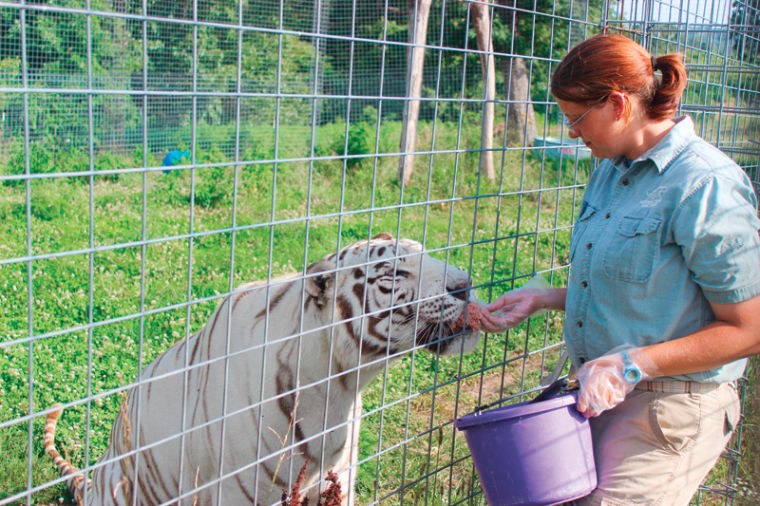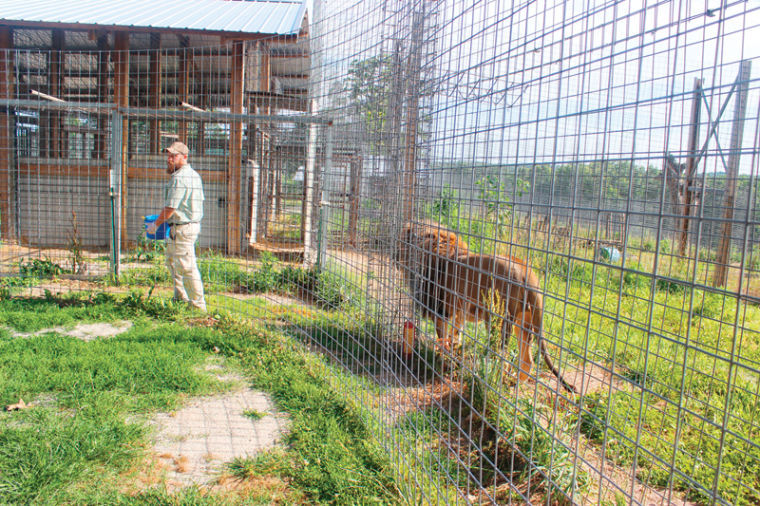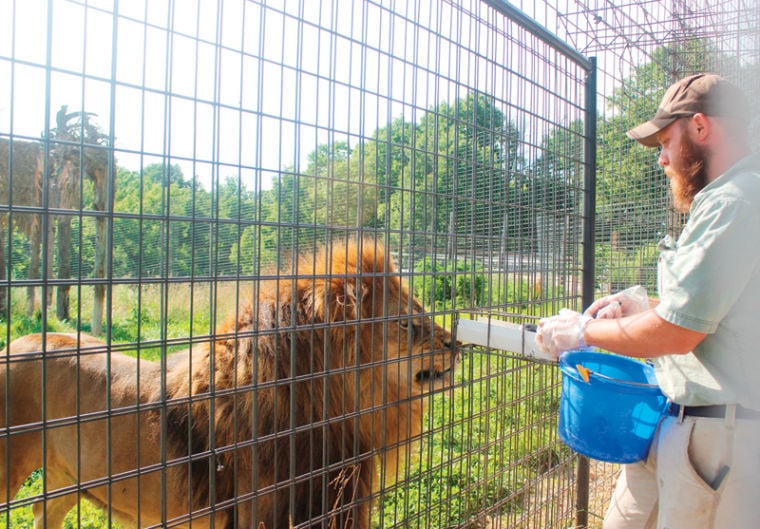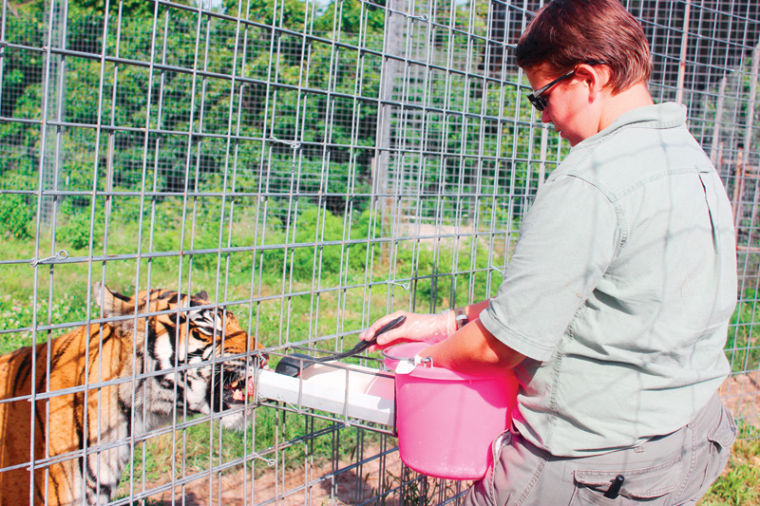Natalie Berry feeds tigger at the National Tiger
Sanctuary Wednesday afternoon. VanBurch’s cats will move to a permanent
habitat like Tigger’s once they become used to their new surroundings.
Merlin follows Josiah Atteberry after the daily feeding in hopes of getting a little more dinner.
Josiah Atteberry feeds Merlin at the National Tiger Sanctuary. Merlin
was donated to the sanctuary several years ago by Kirby VanBurch, and
was the “gateway cat” to VanBurch’s other big cats living at the
sanctuary, according to Abbie Knudsen, with the National Tiger
Sanctuary.
Dietician Beth Boring feeds Sierra at the National Tiger Sanctuary.
With Kirby VanBurch’s five big cats settling into their new homes
at the National Tiger Sanctuary in Saddlebrooke, the employees and
guests of the sanctuary now get to experience the lives of 27 big cats,
ranging from tigers to leopards and lions. Abbie Knudsen, with the National Tiger Sanctuary in Saddlebrooke,
said VanBurch’s cats currently reside in a temporary living space. “This space is to help them get acclimated,” she said. “When they
first come, they’re sort of nervous and apprehensive. Especially these
cats, who have lived inside their whole lives. This gives them an
opportunity to get used to living outside, get used to a different diet
and different people. And then, once they get comfortable, we move them
to their permanent habitats, which are usually 8,000 to 10,000 square
feet for tigers.”
“This is by no means where they’ll live long term,” she said of the tigers’ temporary living space. (The amount of time spent in the temporary habitat) is up to the cat and every cat is different. Sometimes a cat will almost immediately adjust and can go to a permanent habitat pretty quickly, but sometimes it’ll take anywhere from six months to nine months before they’re really comfortable.”
Knudsen said the fact that VanBurch’s cats exclusively lived indoors makes them unique to the sanctuary. “It’s interesting how it changes their condition because they’ve never been in mud, they’ve never gotten a cut, they’ve never broken a whisker,” she said. “They’ve just lived these really sheltered lives and they look pristine — it’s sort of an unusual experience for us.”
Knudsen said the staff at the sanctuary always tries to start new cats in a space that’s close to the size they’ve lived in most of their lives. “If you take a cat that’s lived in a small, small space and you let them into a big habitat, they’ll totally panic,” she said. “It’s a really tough adjustment for them.”
VanBurch’s cats are a little more laid back than many of the cats that come to the sanctuary, Knudsen said. “Normally, to be honest with you, the new cats that come are not this friendly,” she said. “(VanBurch’s) cats are extremely docile.”
When they are ready, VanBurch’s cats will move to their much larger, permanent habitats, when their daily feedings will become part of the sanctuary’s tour. “When we’re feeding the animals their daily meal, that’s sort of the most exciting part of the day around here,” she said.
source
“This is by no means where they’ll live long term,” she said of the tigers’ temporary living space. (The amount of time spent in the temporary habitat) is up to the cat and every cat is different. Sometimes a cat will almost immediately adjust and can go to a permanent habitat pretty quickly, but sometimes it’ll take anywhere from six months to nine months before they’re really comfortable.”
Knudsen said the fact that VanBurch’s cats exclusively lived indoors makes them unique to the sanctuary. “It’s interesting how it changes their condition because they’ve never been in mud, they’ve never gotten a cut, they’ve never broken a whisker,” she said. “They’ve just lived these really sheltered lives and they look pristine — it’s sort of an unusual experience for us.”
Knudsen said the staff at the sanctuary always tries to start new cats in a space that’s close to the size they’ve lived in most of their lives. “If you take a cat that’s lived in a small, small space and you let them into a big habitat, they’ll totally panic,” she said. “It’s a really tough adjustment for them.”
VanBurch’s cats are a little more laid back than many of the cats that come to the sanctuary, Knudsen said. “Normally, to be honest with you, the new cats that come are not this friendly,” she said. “(VanBurch’s) cats are extremely docile.”
When they are ready, VanBurch’s cats will move to their much larger, permanent habitats, when their daily feedings will become part of the sanctuary’s tour. “When we’re feeding the animals their daily meal, that’s sort of the most exciting part of the day around here,” she said.
source




No comments:
Post a Comment